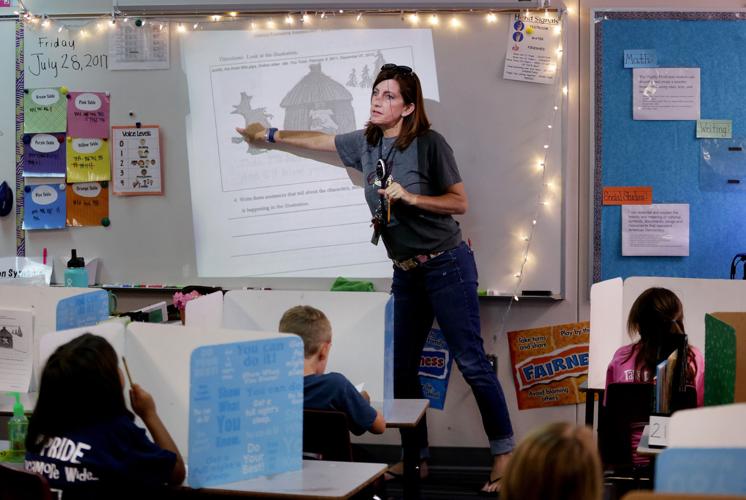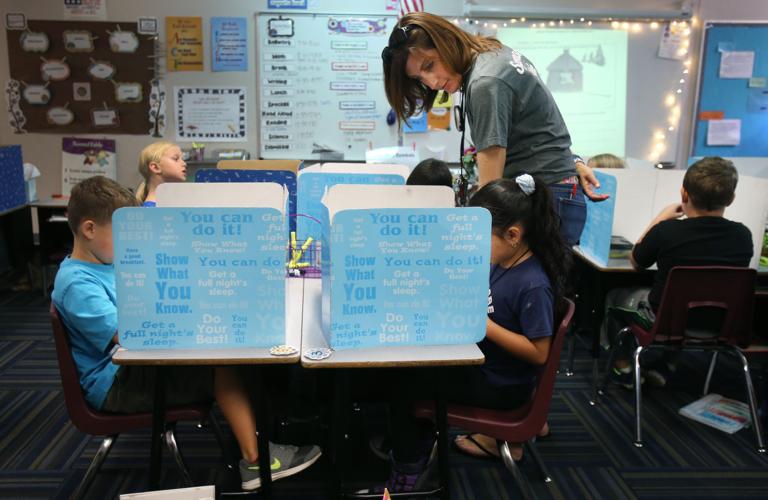As Tucson-area school districts struggle to fill classroom teaching positions, most have decided against an option signed into law by Gov. Doug Ducey — hiring people without any formal teacher training.
The measure, approved in May, was designed to get more teachers into classrooms, yet weeks before the school year was set to begin, Tucson-area districts reported having nearly 200 openings to fill.
Tucson’s largest school district, TUSD, made up the bulk of those vacant teaching positions, with 120 as of Wednesday, July 26. Still, TUSD said it plans to place long-term substitute teachers in classrooms rather than hiring people with no formal training.
“We’re big advocates of teacher certification programs, believing that teaching kids is an art and you learn that in teacher education programs,” said TUSD interim Superintendent Gabriel Trujillo. “I don’t want to make the assumption that someone without certification would be bad for kids. There are a lot of wonderful adults who would do well by kids ... I would say they wouldn’t be as effective as a teacher as somebody who is fully certified.”
The Vail School District, recognized as one of the top achieving districts in the state, however, has decided to give noncertified teachers a shot, putting 40 people with no formal training into classrooms.
As a result, Vail started the new school year two weeks ago with no vacancies in a regular classroom.
“That was a huge accomplishment,” said Vail Superintendent Calvin Baker. “If you look at what’s happening in other school districts in the county, many have over the last couple years as the teacher shortage has become more acute, often students were starting the school year with a substitute teacher. We had to do that in the last couple years and we managed to avoid that this year and we did that because in part we had access to a larger pool of candidates.”
But the Vail School District isn’t just hiring anyone, Baker said.
Of the 24 elementary alternative certification teachers, 17 are Vail School District parents.
“I think that’s a really important statistic because it indicates that the alternative teachers we are hiring, most of them are not just somebody we met or just on a fluke decided to apply and we hired because we are desperate,” Baker said. “These are people we know because their children are going to school here and often their principal said, ‘You should apply.’ And these are people who know us and who have trusted their children to us and have a very strong commitment to making sure our schools are of high quality.”
Up until now, school districts have had to fill teacher vacancies using people with emergency or substitute teacher certifications, both of which require bachelor’s degrees.
The change in the law opens up teaching to people with no formal training as long as they can pass a background check and meet one of the following criteria: for those without bachelor’s degrees, five years of relevant experience in the subject they wish to teach is needed; having a higher education degree in a relevant subject matter will also do.
BEYOND CONTENT
Opponents of the law argue that knowing the content isn’t enough.
As with most things, it takes time to learn to teach, said Renee Clift, professor and associate dean at the University of Arizona’s College of Education.
“High-quality teacher programs help people understand the basics, give them a chance to practice, give them feedback and consultation,” Clift said. “We give them chances to expand but all in a very safe environment because they’re not the teacher on record.”
Arizona schools chief Diane Douglas agrees.
“There was a philosophy that if you knew how to teach you could teach everything and now it seems we’re swinging in another direction that says if you know your content area, you don’t need to understand management or other things as much, but to me, both pieces are vitally important,” she said.
“You have to have a good working knowledge of the content, but also adolescent development,” added Flowing Wells School District Superintendent David Baker. “Understanding what teenagers are going through developmentally, emotionally. What’s happening with relationships between students and parents, how homework might be processed. Those are important, especially working with adolescents.... We firmly believe in fully certified teachers.”
None of that is lost on Baker, the Vail superintendent.
All newly hired Vail teachers take part in a two-year new teacher induction program and are assigned a mentor teacher.
“We took that one step further this year because we realize we have teachers that were coming to us, many of them without teaching experience,” Calvin Baker said. “So every teacher in the alternative certificate program has a direct coach. That is somebody who has a relationship with them who would be somewhat similar to a teaching supervisor. They come in on a regular basis and are very direct saying ‘you need to do this, you need to change that’ to provide an increased level of supervision and direct feedback.”
As those teachers demonstrate they have their feet on the ground and are moving in the right direction, they are graduated into the district’s regular coaching program.
Because Vail schools follow the same curriculum calendar, new teachers have the benefit of planning lesson with seasoned educators as well as someone to debrief with, Calvin Baker said.
“That’s the most significant help alternative teachers can have,” he said.
The Catalina Foothills School District, which had a dozen vacancies to fill a month before the first day of school, had no plans to hire individuals with no teacher training but if that did occur, there would need to be a development plan directed at becoming fully credentialed, said Superintendent Mary Kamerzell.
TACKLING THE SHORTAGE
While Vail is taking advantage of the flexibility in the law, Calvin Baker said changing teacher qualifications isn’t the final answer.
“This is not the solution,” he said. “It’s the way we are dealing with the problem and we’re dealing with it constructively, but teachers need to make more.”
Arizona loses more than 40 percent of new teachers within the first three years, according to Douglas. Reasons include Arizona’s low wages and lack of support in the classrooms.
“Within the U.S., and even in Arizona, we have plenty of certified teachers,” Clift said. “They’re just not teaching. ... Salary in Arizona is huge and if people have the option to leave, they do.”
Douglas hopes to get teachers an 11 percent pay raise and an additional $100 million a year for school repairs through a full cent sales-tax increase.
In the meantime, TUSD is working on starting recruiting efforts sooner, and expanding stipends and salary increases, especially in areas of teacher shortages, like math, special education, English as a second language and reading specialists, Trujillo said.
The Sunnyside Unified School District, Tucson’s second-largest district, has developed partnerships with UA South, Pima College, Grand Canyon University and other colleges and programs that offer alternative certification programs for professionals to pursue teacher certification, said district spokesman Victor Mercado.
It’s not enough to get teachers in the door, Clift said. Retaining teachers is equally important.
Giving teachers freedom to be creative in classrooms goes a long way, Clift said.
“Once teachers have learned the basics, allow them to be creative and continuously work on meeting the needs of all the children,” Clift said. “The ability to be creative and innovative is one thing that keeps people in the profession.”
Whether SB 1042 will be successful is a matter of time, Douglas said.
“But unfortunately, when time tells if it’s not successful or as successful as we hope from the onset, what happens to those children in the meantime? That’s always my concern.”





